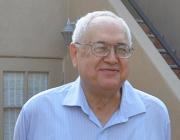Date Published:
SEP 1Abstract:
The conformation and structural dynamics of cellobiose, one of the fundamental building blocks in nature, its C4' epimer, lactose, and their microhydrated complexes, isolated in the gas phase, have been explored through a combination of experiment and theory. Their structures at low temperature have been determined through double resonance, IR-UV vibrational spectroscopy conducted under molecular beam conditions, substituting D2O for H2O to separate isotopically, the carbohydrate (OH) bands from the hydration (OD) bands. Car-Parrinello (CP2K) simulations, employing dispersion corrected density functional potentials and conducted ``on-the-fly'' from similar to–'20 to similar to 300 K., have been used to explore the consequences of raising the temperature. Comparisons between the experimental data, an harmonic vibrational self-consistent field calculations based upon ab initio potentials, and the CP2K simulations have established the role of anharmonicity; the reliability of classical molecular dynamics predictions of the vibrational spectra of carbohydrates and the accuracy of the dispersion corrected (BLYP-D) force fields employed; the structural consequences of increasing hydration; and the dynamical consequences of increasing temperature. The isolated and hydrated cellobiose and lactose units both present remarkably rigid structures: their glycosidic linkages adopt a ``cis'' (anti-phi and syn-psi) conformation bound by inter-ring hydrogen bonds. This conformation is maintained when the temperature is increased to similar to 300 K and it continues to continus to be maintained when the cellobiose(or lactose) unit is hydrated by one or two explicitly bound water molecules. Despite individual-fluctuations in the intra- and intermolecular hydrogen bonding pattern and some local structural motions, the water molecules remain locally bound and the isolated carbohydrates remain trapped within the cis potential well. The Car-Parrinello dynamical simulations do not suggest any accessible pathway to the trans conformations that are formed in aqueous solution and are widespread in nature.
